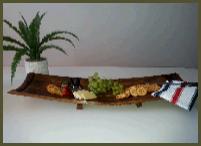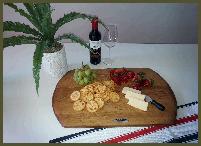
Firebending |
Firebending then involves dousing the inside of the wine barrel with water before lighting a small controlled fire within the barrel. The combination of heat and humidity softens the lignin in the wood and makes it flexible enough to bend with ta big vice. |
This is a very slow process but after about an hour the barrel has been bent into shape and cooper will make final adjustments before toastin' the barrel. |
Toasting the barrel? |
Toasting is a process of burning the inside of the wine barrel to achieve different oak flavour influences in the wine. Barrel toasting can be light, medium or heavy or anything in-between depending on the winemaker |
Toasting mellows the tannins in the wood and changes the flavors the barrel might impart from raw wood to more spicy, vanilla notes. Toasting actually helps release vanillin from the cells in the wood. |
Lighter toasting results in a stronger oak flavour and tannins in the wine, while heavier toasting gives more spicy, toasty oak flavours. |
Why the particular shape of the barrel? |
The circular shape helps to withstand internal and external pressures. Full barrels are very heavy, so it also makes it easier to store or move the barrels. The bowed shape makes it quite easy to steer the barrel in the desired direction as it is being rolled. |
|
What is the anatomy of a barrel? |
A barrel is made up of a number of wooden staves, bound by metal hoops to hold them in the circular shape. The selection of the wood for the staves is determined by availability of trees, but in the case of barrels used for aging of wines or liquor, also the flavor characteristics the wood adds to the liquid |
How is it made? |
Once the oak wood was selected, it gets split and turned into staves. Staves are laid out to air dry for 18 to 36 months to allow the wood to ‘season. |
To make the wine barrel shape, the staves must be carefully cut to be narrower at the ends and wider in the middle. |
The cooper then selects and lines up the staves. While each wine barrel is slightly different, traditional wine barrels have about 25-30 staves. Two staves are then attached to a metal hoop that forms the structure to which the others are added. |
Preparing the staves |
The staves must be cut narrower at the ends and wider in the middle. Getting the shape of the staves right is essential so that when they are brought together and curved into shape the barrel is watertight without the aid of glue. |
Two staves are then attached to a metal hoop that forms the structure to which the others are added. |
Once the staves are in place, the cooper will fit a a thick metal hoop that fits around and helps shape the barrel and remove the original hoop used to fix the staves. |







Wine Barrels |
Cutting Boards |
Firewood Buckets |
Candle Stands |
Coffee Tables |
Bar Stools |
Mini Bars |
Coat Hangers |
Wine Racks |
Shelf Lamps |
Custom Designs |
